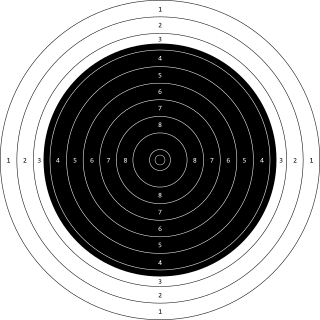
International Rifle events that occur in three positions are conducted with an equal number of shots fired from the Kneeling, Prone and Standing positions, although the order has changed over the years. Each of the three positions shot during the match has a fixed time limit that the shooter is able to shoot unlimited numbers of sighting shots and 10 or 20 shots for record.
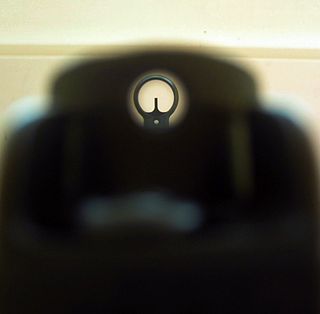
Iron sights are a system of physical alignment markers used as a sighting device to assist the accurate aiming of ranged weapons, or less commonly as a primitive finder sight for optical telescopes. The earliest sighting device, it relies completely on the viewer's naked eye, and is distinctly different to optical sights such as telescopic sights, reflector (reflex) sights, holographic sights and laser sights, which make use of optical manipulation and/or active illumination.
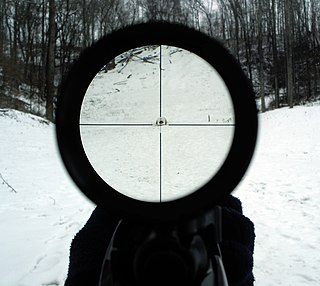
A telescopic sight, commonly called a scope informally, is an optical sighting device based on a refracting telescope. It is equipped with some form of a referencing pattern – known as a reticle – mounted in a focally appropriate position in its optical system to provide an accurate point of aim. Telescopic sights are used with all types of systems that require magnification in addition to reliable visual aiming, as opposed to non-magnifying iron sights, reflector (reflex) sights, holographic sights or laser sights, and are most commonly found on long-barrel firearms, particularly rifles, usually via a scope mount. Similar devices are also found on other platforms such as Artillery, Tanks and even Aircraft. The optical components may be combined with optoelectronics to add night vision or smart device features.

Metallic silhouette shooting is a group of target shooting disciplines that involves shooting at steel targets representing game animals at varying distances, seeking to knock the metal target over. Metallic silhouette is shot with large bore rifles fired freehand without support out to 500 meters, and with large bore handguns from the prone position with only body support out to 200 meters. Competitions are also held with airguns and black-powder firearms. A related genre is shot with bow and arrow, the metal targets being replaced with cardboard or foam. The targets used are rams, turkeys, pigs, and chickens, which are cut to different scales and set at certain distances from the shooter depending on the specific discipline.

Boresighting is a method of visually pre-aligning a firearm barrel's bore axis with the target, in order to more easily zero the gunsight. The process is usually performed on a rifle, and can be accomplished either with the naked eye, or with a specialized device called a boresighter.

10 metre air rifle is an International Shooting Sports Federation (ISSF) shooting event, shot at a bullseye target over a distance of 10 meters using a 4.5 mm (0.177 in) calibre air rifle with a maximum weight of 5.5 kg (12.13 lb). It is one of the ISSF-governed shooting sports included in the Summer Olympics since the 1984 Los Angeles Games.
The Sturmgewehr 57 is a selective fire battle rifle designed by Schweizerische Industrie Gesellschaft of Switzerland. It uses a roller-delayed blowback system similar to the H&K G3 and CETME rifles. The AM 55 entered service in the Swiss Army with the designation F. ass. 57 7.5mm or 7.5mm Stgw. 57, with export variations constituting the SG 510 family of small arms.
The Karabiner Modell 1931 is a magazine-fed, straight-pull bolt-action rifle. It was the standard issue rifle of the Swiss armed forces from 1933 until 1958 though examples remained in service into the 1970s. It has a 6-round removable magazine, and is chambered for the 7.5×55mm Swiss Gewehrpatrone 1911 or GP 11, a cartridge with ballistic qualities similar to the 7.62×51mm NATO/.308 Winchester cartridge. Each rifle included a 6-round detachable box magazine with matching stamped serial number. A stripper clip can be used to load the magazine from the top of the receiver.
The SSG 69 is a bolt-action sniper rifle produced by Steyr Mannlicher that serves as the standard sniper rifle for the Austrian Army.
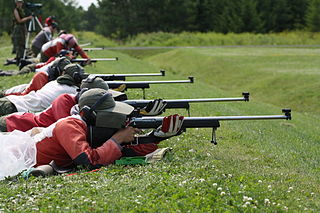
Fullbore Target Rifle (TR) is a precision rifle shooting sport discipline governed by the International Confederation of Fullbore Rifle Associations (ICFRA). The sport evolved as a distinct British and Commonwealth of Nations discipline from Service rifle (SR) shooting in the late 1960s. Its development was heavily influenced by the British National Rifle Association (NRA). Due to this history, it is usually contested amongst the shooting events at the Commonwealth Games, although not at the Olympics. World Championships are held on a four-year cycle. The annual NRA Imperial Meeting at Bisley in the UK is globally recognised as a historic annual meeting for the discipline.

"Swedish Mausers" are a family of bolt-action rifles based on an improved variant of Mauser's earlier Model 1893, but using the 6.5×55mm Swedish cartridge, and incorporating unique design elements as requested by Sweden. These are the m/94 carbine, m/96 long rifle, m/38 short rifle and m/41 sniper rifle. Production began in 1898 at Carl Gustafs stads Gevärsfaktori in Eskilstuna, Sweden.
The Kongsberg M67 is a bolt-action sharpshooter rifle made by Kongsberg Våpenfabrikk of Norway, based on actions from Mauser M98k left by German armed forces in 1945. The M67 replaced the M59 in 1967 and was produced until the 1990s. The rifle is sometimes unofficially referred to as Mauser M67. However, both M59 and M67 were not licensed products of Mauser, but were produced by Kongsberg and marketed as such.
The Walther LGR air rifle was developed by the German arms manufacturer Carl Walther GmbH Sportwaffen as a high end match rifle for 10 metre air rifle competition shooting. The LGR was the first match air rifle that employed the then futuristic single-stroke pneumatic method as power source. This use of pre compressed air introduced the advantages of recoilless and vibration free shooting in combination with a well-made air rifle into the sport. It took other manufacturers a decade before they also introduced single-stroke pneumatic match air rifles.

The diopter is an aperture sight component used to assist the aiming of devices, mainly firearms, airguns, and crossbows. It is found in particular as a rear sight element on rifles.
The SIG Sauer 200 STR, also known as the SIG Sauer 200 STR Match, is a bolt-action rifle mostly used as a target/competition rifle for national competitions by Norwegian, Swedish and Danish sport shooters. It is a variant of the Sauer 200 TR or SIG Sauer 200 TR Match rifle that features thicker 19 mm (0.75 in) diameter barrels. The 200 STR is produced by J. P. Sauer & Sohn GmbH in Germany.
The Colt Canada C19 is a licence-built, Finnish-designed Tikka T3 CTR bolt-action rifle modified for the Canadian Rangers. The C19 replaced the longer and heavier Lee-Enfield No. 4 Mk.1 rifles which entered service in 1947.
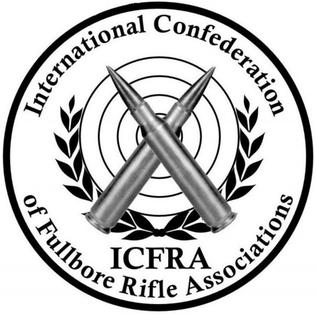
The International Confederation of Fullbore Rifle Associations (ICFRA) is the international association for the fullbore rifle shooting sports of Target Rifle ('TR') (in the US 'Palma' Rifle) and F-Class, which are long range competitions shot at distances between 300 and 900 meters or 300 to 1,000 yards depending on the range. F-Class shooters often shoot concurrently with the world's long-range TR shooters and use the same targets, except that the F-Class target has an extra ring half the diameter of the smallest in use for TR. ICFRA manages the programme of World Championships and other major matches for Fullbore Rifle and seeks to standardize the competition rules for TR and F-Class around the world. In competitions, wind reading skills are important. In order to hit their targets competitors must sense wind direction and speed and adjust their sights accordingly by applying knowledge and experience about wind's effect on the Trajectory of the bullet. World Long-Range Rifle Team and Individual Championships for both TR and F-Class are hosted every four years alternately two years apart. The winner of the World Long Range TR Team Championship is awarded the Palma trophy.
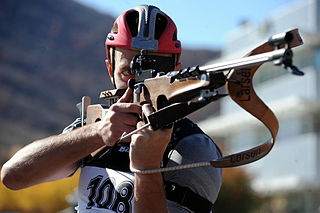
A Biathlon rifle is a specialized rifle designed for use in a biathlon event. Specialist biathlon rifles are ultra lightweight, and usually equipped with straight-pull actions, integrated magazine carriers, and ergonomic stock designs suitable for both prone and standing positions.
SIG Sauer 205 is a bolt-action rifle formerly produced by SIG Sauer. The rifle was produced in several variants for competition shooting and law enforcement.

Shooting glasses are specialized corrective glasses for use in shooting and are used almost exclusively in sport shooting competitions. Like other glasses, they are worn in front of the eyes to compensate for the shooter's ametropia with optical lenses.


















